Aimee
Forum Replies Created
Viewing 10 posts - 1 through 10 (of 10 total)
-
AimeeParticipantPast on the left, current try on the right. Learning to look at negative shapes and how different parts relate to each other was very helpful in laying down the draft sketch. I've been avoiding watercolor for 20+ years, and finally through learning techniques taught by Liz I am really enjoying it. Waiting for the paint to dry between layering and faintly erasing pencil lines before coloring were two techniques that really helped me move forward. Still need practice on proportion & color mixing.
 in reply to: See How Far You’ve Come #652303
in reply to: See How Far You’ve Come #652303 -
AimeeParticipant

 Two drawings from the same sit spot. I am finding these exercises are helping me loosen up and work faster, not paying so much attention to detail, but rather focusing on composition, shape, and gesture. Just getting used to juggling my materials in the field. in reply to: Filling Your Sketches with Color #649847
Two drawings from the same sit spot. I am finding these exercises are helping me loosen up and work faster, not paying so much attention to detail, but rather focusing on composition, shape, and gesture. Just getting used to juggling my materials in the field. in reply to: Filling Your Sketches with Color #649847 -
AimeeParticipant
 I've played around with watercolors on my own with no real training. I tend to use colors right out of the pan (I have more color options) so this was very helpful to learn properties of mixing, tinting, toning, etc.
I've created small palettes for the two images above and two birds see in the field today. Once I started picking out colors in the landscape I got overwhelmed with how many colors are actually there. I think I'll focus future palettes on picking out the most dominant and what best exemplifies field markings for quick studies, then go more into depth for finish pieces. in reply to: Capturing Nature’s Color Palettes #648709
I've played around with watercolors on my own with no real training. I tend to use colors right out of the pan (I have more color options) so this was very helpful to learn properties of mixing, tinting, toning, etc.
I've created small palettes for the two images above and two birds see in the field today. Once I started picking out colors in the landscape I got overwhelmed with how many colors are actually there. I think I'll focus future palettes on picking out the most dominant and what best exemplifies field markings for quick studies, then go more into depth for finish pieces. in reply to: Capturing Nature’s Color Palettes #648709 -
AimeeParticipantThis exercise was a good test in patience. I found myself drawing a lot slower and using my eraser more than usual. It was hard not to sketch an overall shape of the bird to get proportion right, so mine came out a bit more slender than it should've been.
 in reply to: Drawing What You See – Upside Down Drawing #648580
in reply to: Drawing What You See – Upside Down Drawing #648580 -
AimeeParticipant
 I enjoyed this exercise, I think it is a good practice in slowing down and will be a good technique to lead with to warm up my hand in the field. The quality got better as I went on after working on a few of them, still finding my proportion of returning to my starting line can be way off. Looking forward to practicing this on 3D subjects. in reply to: Focusing on Your Subject – Blind Contour Drawing #647601
I enjoyed this exercise, I think it is a good practice in slowing down and will be a good technique to lead with to warm up my hand in the field. The quality got better as I went on after working on a few of them, still finding my proportion of returning to my starting line can be way off. Looking forward to practicing this on 3D subjects. in reply to: Focusing on Your Subject – Blind Contour Drawing #647601 -
AimeeParticipant
 I really enjoyed this exercise! in reply to: Opening Your Senses #646816
I really enjoyed this exercise! in reply to: Opening Your Senses #646816 -
AimeeParticipant
 I did this exercise indoors because the weather was very bad today, I think my observation would have benefitted from being outdoors and also comparing leaves, branch and bark of the two trees. Now looking at other submissions I'd like to include scale measurements in upcoming drawings as well. in reply to: The Power of Comparison #646815
I did this exercise indoors because the weather was very bad today, I think my observation would have benefitted from being outdoors and also comparing leaves, branch and bark of the two trees. Now looking at other submissions I'd like to include scale measurements in upcoming drawings as well. in reply to: The Power of Comparison #646815 -
AimeeParticipant
 I practiced a few of the mark making techniques using the same subject to see how different styles might lend themselves to different textures. I can now see what works better in the field too for quick capturing as the processes took longer to do the more detailed they got. in reply to: Illustrating the 3D World #646150
I practiced a few of the mark making techniques using the same subject to see how different styles might lend themselves to different textures. I can now see what works better in the field too for quick capturing as the processes took longer to do the more detailed they got. in reply to: Illustrating the 3D World #646150 -
AimeeParticipant1. In order to work quicker and looser I gave myself 5 minutes to sketch the bird then went in with color without looking at the picture. Though a yellow warbler would not sit still that long! I wanted to challenge myself to not focus on detail but rather get the bigger picture. 2. I noticed the 5+ species of lichen that I would not have generally thought to draw prior to this exercise. I'd like to use this in the field, by getting the subject in quickly (since I won't have much time with a moving subject), then going in after and focus on inventorying other aspects from the habitat.in reply to: Jump Right in! #645367
-
AimeeParticipant1. I am an artist and a naturalist, I have been drawing from my own photographs (plants, birds & fungi) for a few years, but have increasingly become frustrated with the amount of time this requires in front of a screen. While it has been very useful to create detailed drawings, I'd like to introduce nature journalling to expand upon my time outdoors, to slow down and really study things in 3D (movement, behavior, habitat, emotion, etc.), rather than recreating a flat image. 2. I appreciate the looseness of the some of the sketchbooks, as I tend to focus on detail, I am hoping this course will help me loosen up, to create a more free flowing record of what I'm observing. 3. Additionally I want to include notes on sounds I am hearing.in reply to: Style Your Journal Your Way #645154
Viewing 10 posts - 1 through 10 (of 10 total)
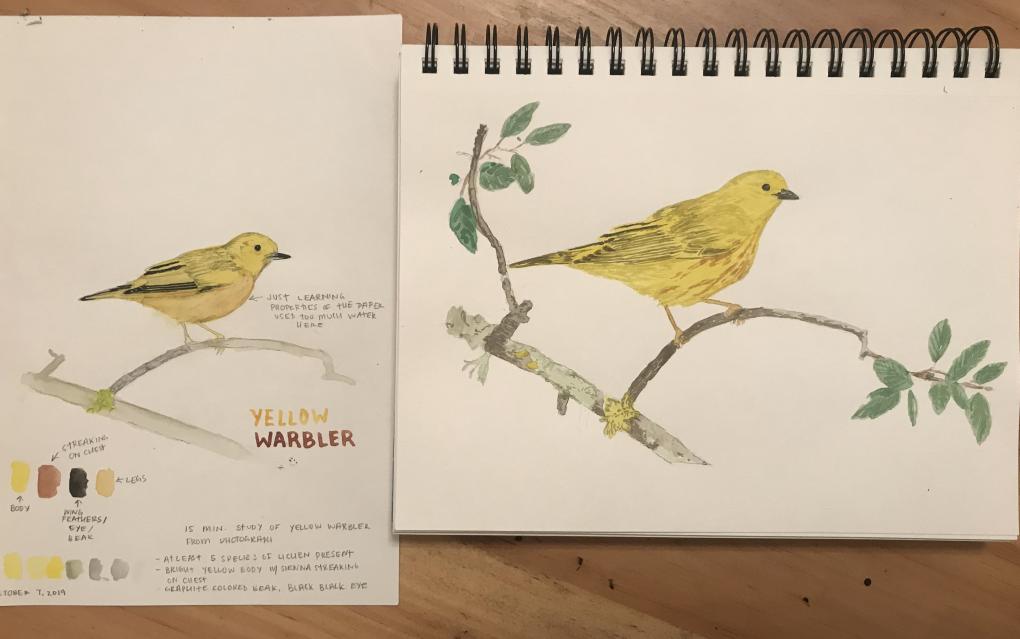
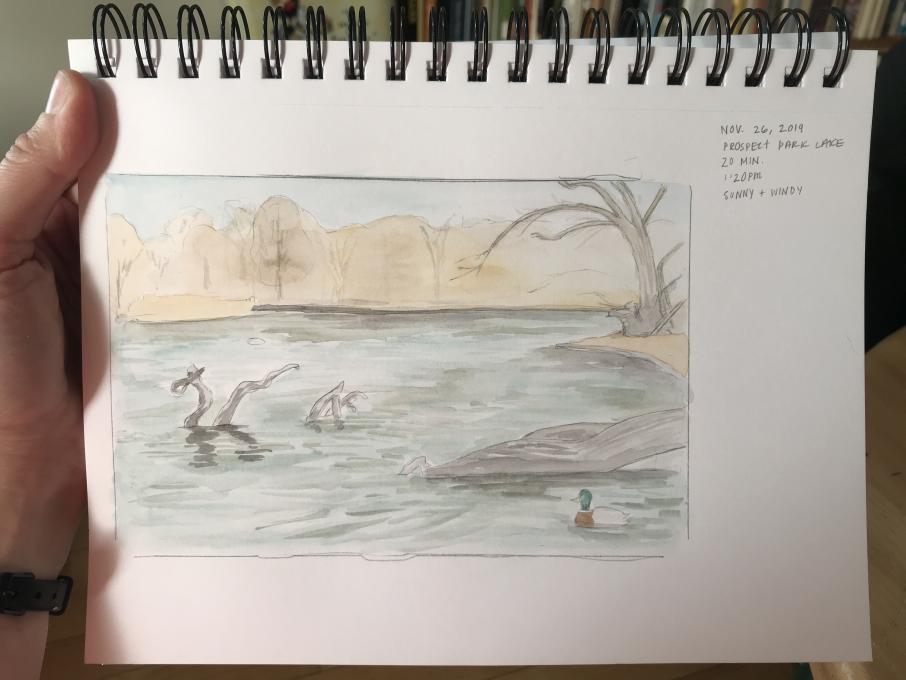
 Two drawings from the same sit spot. I am finding these exercises are helping me loosen up and work faster, not paying so much attention to detail, but rather focusing on composition, shape, and gesture. Just getting used to juggling my materials in the field.
Two drawings from the same sit spot. I am finding these exercises are helping me loosen up and work faster, not paying so much attention to detail, but rather focusing on composition, shape, and gesture. Just getting used to juggling my materials in the field. 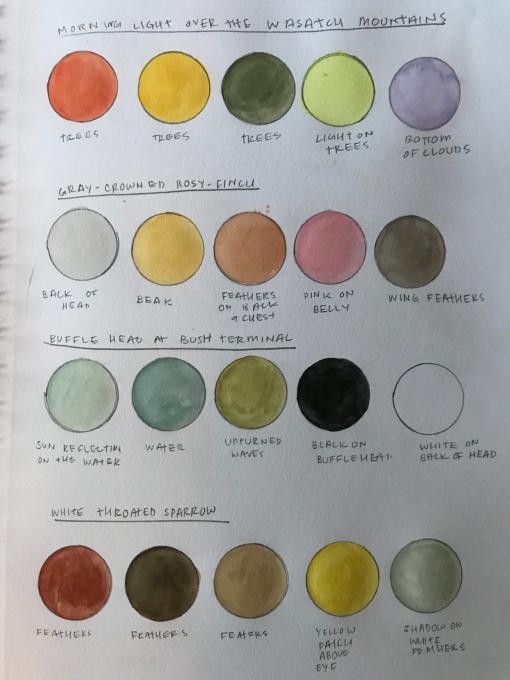 I've played around with watercolors on my own with no real training. I tend to use colors right out of the pan (I have more color options) so this was very helpful to learn properties of mixing, tinting, toning, etc.
I've created small palettes for the two images above and two birds see in the field today. Once I started picking out colors in the landscape I got overwhelmed with how many colors are actually there. I think I'll focus future palettes on picking out the most dominant and what best exemplifies field markings for quick studies, then go more into depth for finish pieces.
I've played around with watercolors on my own with no real training. I tend to use colors right out of the pan (I have more color options) so this was very helpful to learn properties of mixing, tinting, toning, etc.
I've created small palettes for the two images above and two birds see in the field today. Once I started picking out colors in the landscape I got overwhelmed with how many colors are actually there. I think I'll focus future palettes on picking out the most dominant and what best exemplifies field markings for quick studies, then go more into depth for finish pieces. 
 I enjoyed this exercise, I think it is a good practice in slowing down and will be a good technique to lead with to warm up my hand in the field. The quality got better as I went on after working on a few of them, still finding my proportion of returning to my starting line can be way off. Looking forward to practicing this on 3D subjects.
I enjoyed this exercise, I think it is a good practice in slowing down and will be a good technique to lead with to warm up my hand in the field. The quality got better as I went on after working on a few of them, still finding my proportion of returning to my starting line can be way off. Looking forward to practicing this on 3D subjects. 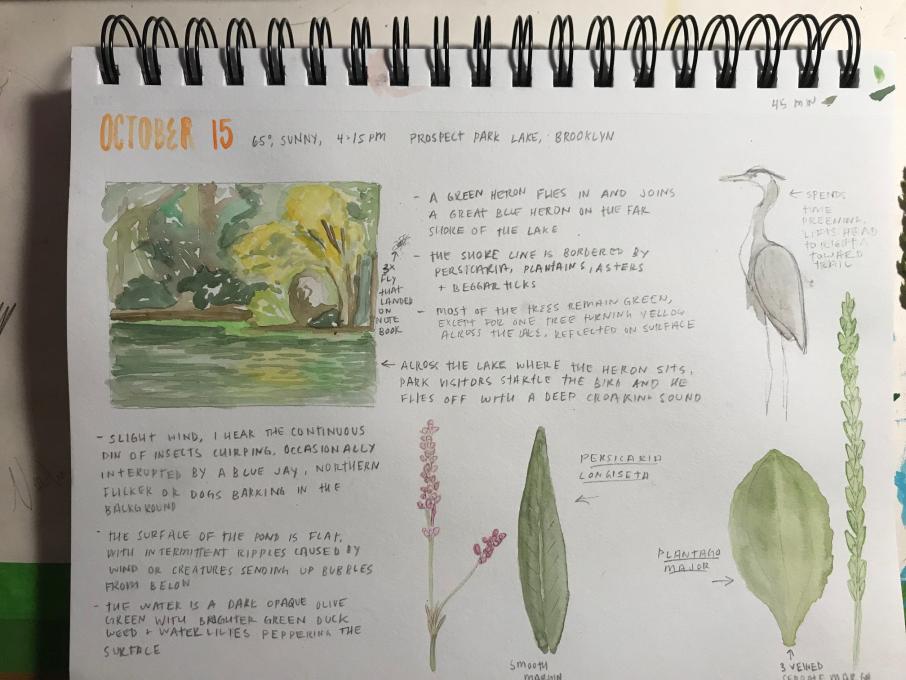 I really enjoyed this exercise!
I really enjoyed this exercise! 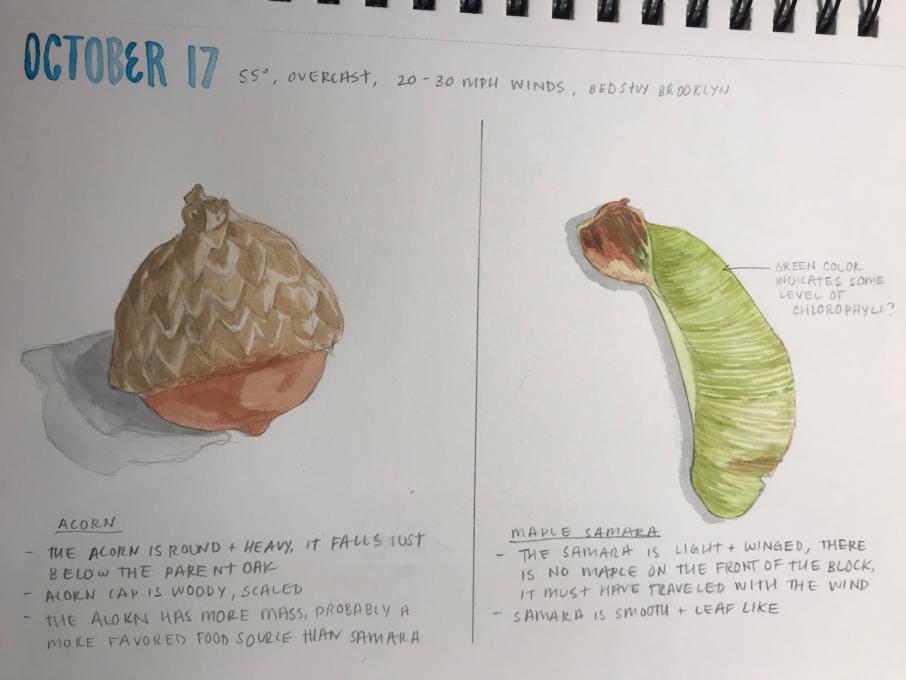 I did this exercise indoors because the weather was very bad today, I think my observation would have benefitted from being outdoors and also comparing leaves, branch and bark of the two trees. Now looking at other submissions I'd like to include scale measurements in upcoming drawings as well.
I did this exercise indoors because the weather was very bad today, I think my observation would have benefitted from being outdoors and also comparing leaves, branch and bark of the two trees. Now looking at other submissions I'd like to include scale measurements in upcoming drawings as well. 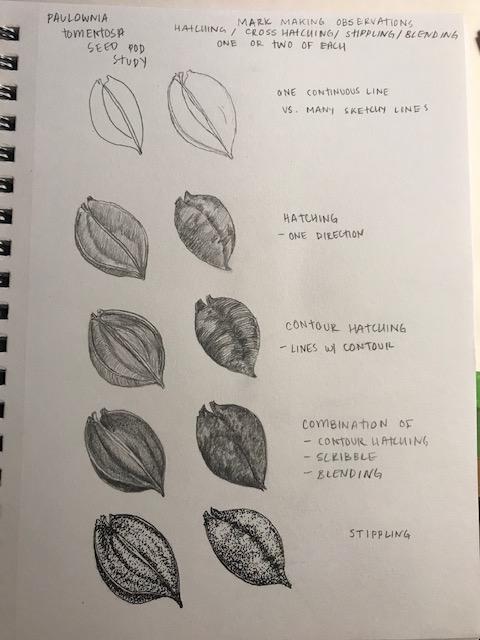 I practiced a few of the mark making techniques using the same subject to see how different styles might lend themselves to different textures. I can now see what works better in the field too for quick capturing as the processes took longer to do the more detailed they got.
I practiced a few of the mark making techniques using the same subject to see how different styles might lend themselves to different textures. I can now see what works better in the field too for quick capturing as the processes took longer to do the more detailed they got.